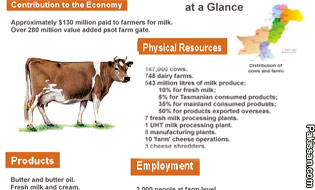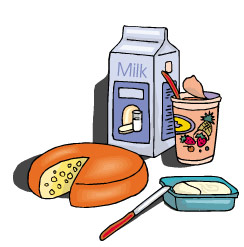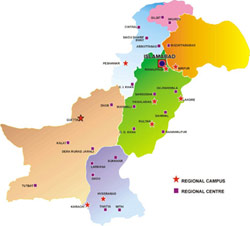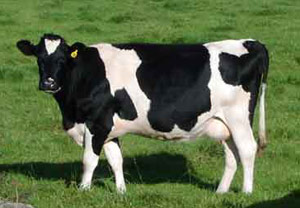|
All About/
Live stock
|
More
|
Dairy industry in
Pakistan
With the every passing day, dairy products are becoming
costlier because live stock farming has not scientifically
grown with the increase in population and also it did not
match with the pace of urbanisation.
 Recently,
milk prices in Karachi increased without any reason. In a
short time of two years, milk prices have gone up from Rs 20
per liter to Rs 25, showing a 25 percent increase. Moreover,
meat prices have also risen to about 25 percent in the last
six months. Recently,
milk prices in Karachi increased without any reason. In a
short time of two years, milk prices have gone up from Rs 20
per liter to Rs 25, showing a 25 percent increase. Moreover,
meat prices have also risen to about 25 percent in the last
six months.
In such a situation, the only way to control prices is to
develop the dairy industry on scientific lines, which will not
only provide meat and milk in abundant quantities to the
domestic consumers but extra quantities can also be exported.
In spite of having a large population of LIVESTOCK, the
country is spending some $40 million annually on the import of
formula milk only, which is the highest amount spent by any
country in the world on this particular commodity.
Currently, there are some 160
varieties of infant formula milk available in the markets.
While breast milk is the best a mother can give her infant
in terms of a balanced and healthy diet.
LIVESTOCK is an important sector of agriculture in Pakistan.
It accounts for 39 percent of agricultural value added and
about 9.4 percent of the GDP. Its net foreign exchange
earnings, in 2001-02, were Its 51.5 billion, which was 12.3
percent of the overall export earnings of the country.
 The
role of LIVESTOCK can be judged from the fact that about 35
million people are engaged in raising 2 to 3
cattle/buffaloes and 5 to 6 sheeps/goats in their backyards
and are deriving 20 to 25 percent income from it. The
role of LIVESTOCK can be judged from the fact that about 35
million people are engaged in raising 2 to 3
cattle/buffaloes and 5 to 6 sheeps/goats in their backyards
and are deriving 20 to 25 percent income from it.
The LIVESTOCK, include cattle, buffaloes, sheep, goats,
camels, horses, asses and mules. During the last five years,
the combined population of cattle, buffalo, sheep and goat
increased from 113 million, 1998-99, to 125 million,
2002-03, depicting a total increase
of 12 million or 24 lac heads per annum.
In the year 2002-03, the domestic live stock population was
estimated at 23.3 million cattle, 24.8 million buffalo, 24.6
million sheep and 52.8 million goats. During 1998-03,
maximum increase was in the population of goats, showing an
increase of 70 lac heads or 14 lac heads per annum.
During this period, production of beef increased from 963 to
1060 thousand tons and mutton from 633 to702 thousand tonnes.
This shows that the total increase in beef production was
97,000 tonnes or 15.4 thousand tonnes p.a., and mutton
69,000 tonnes or 14,000 tonnes.
TABLE - 1:
============================================
Production of LIVESTOCK Products
--------------------------------------------------------------
Product 1998-99 1999-00 2000-01 2001-02 2002-03
Milk 24,877 25,566 26,284 27,031 27,811
Beef 963 986 1010 1034 1060
Mutton 633 649 666 683 702
============================================
The per capita availability of milk was 150 litre and meat
19kg per annum in 2000-01, which comes to 0.41 litre milk
per day and 5.2 grams meat per day.
To meet the domestic demand of milk and meat, the rate of
growth must be at least 5 to 7 percent per annum.
Despite an increase in milk and meat production, the prices
have moved upward abnormally.
The recent increase in meat prices is attributed to the export
of live animals or meat to the Middle East and Afghanistan.
There was a time when animals used to be imported or smuggled
from Afghanistan into Pakistan but after 9/11 the situation
suddenly took a 'U' turn. In Afghanistan, the war has
seriously affected the LIVESTOCK sector.
Thus Pakistan started exporting instead of importing LIVESTOCK
from Afghanistan.
According to official figures during July-August, 2002,
animals worth Rs 30 million made their way to Afghanistan.
Besides, the smuggling of LIVESTOCK from Pakistan to
Afghanistan has also started in a big way to meet their
domestic shortage of animals.
The country, though rich in LIVESTOCK, rarely got a chance to
export meat or meat products to earn foreign exchange. It
was offered an opportunity when various Middle East states
stopped importing meat from European countries due to the
incidence of the mad cow disease.
Meat export from Lahore started in the beginning of the year
2000 when carcasses of goats and large animals were
airlifted.
The meat was processed under a special arrangement between the
exporters and the Metropolitan Corporation of Lahore, which
runs four abattoirs in the city.
The exports of LIVESTOCK - cow, buffalo, sheep and goat - are
finding their way to the Gulf States, Iran and Afghanistan
where there is a shortage of good quality meat and,
therefore, it commands a high price.
Traditionally, Europe was the biggest exporter of meat and
meat by-products and LIVESTOCK and had been a major source
of foreign exchange for several European countries.
Technically, meat from South Asia has a superior quality, due
to grazing and vegetable concentrates as the main source of
LIVESTOCK feed here, against bone and meat meal in Europe.
According to official figures, the export of LIVESTOCK, during
2001-02, registered an abnormal growth of 51 percent to a
value of Rs 221 million as compared to 2000-01, when exports
of meat stood at Rs 146 million.
The estimated export of these four categories of LIVESTOCK is
estimated to be more than Rs 275 million during the fiscal
year of 2002-03.
A rising trend in LIVESTOCK export was also sustained during
the first two months of current fiscal year as exports of
animals worth Rs 43 million were reported to have been
achieved.
There is a greater possibility that this trend would go
unbridled if the government does not take corrective
measures to ensure a steady supply of animals in the
domestic market.
As a result of this, the value-added leather industry,
including leather garment manufacturers who mostly use raw
hides and skins obtained from cows, buffaloes, sheeps and
goats are faced with a shortage of raw material.
Therefore, the Pakistan Leather Garments Manufacturers &
Exporters Association (PLGMEA) chairman Fawad Ijaz and the
Pakistan Tanners Association chairman S.M Naseem has urged
the government to immediately impose a ban on export of
LIVESTOCK.
 If
Pakistan wants to continue meat and live animal export,
besides meeting domestic demand, modern meat processing
plants and LIVESTOCK farms should be set up all over the
country. If
Pakistan wants to continue meat and live animal export,
besides meeting domestic demand, modern meat processing
plants and LIVESTOCK farms should be set up all over the
country.
Here we are giving some details of new to set up a unit to
raise 50 animals on commercial basis, for more details Smeda
can be contacted.
DAIRY FARM OF 50 ANIMALS PROJECT BRIEF:
Dairy farming is an agro-based activity, buffaloes and cows
can be raised for milk production in an organised manner for
commercial purpose.
For this project, animals can be purchased from the animal
markets or breeders in Sahiwal, Sheikhupura, Faisalabad.
More than 70 percent farmers hold less than 5 acres of land.
Dairy farming may prove a profitable business for small
landholders.
They can also grow fodder on their land to feed dairy animals,
without disturbing the main crop.
Dairy farming is one of the best projects if professionally
done on small land holdings. The return of the land used for
feeding animals is higher as compared to land used for
traditional cropping.
The economical size of the herd is 50 animals, which will grow
into 180 animals within a few years. Cows are also proposed in
the herd, as they are high yields and efficient converters of
feed into milk.
This herd would consist of 75 percent buffaloes and 25 percent
cows. A cow, on average, yields 14 litres milk a day over a
lactation period of 305 days whereas the buffalo, on an
average, yields 10 litres a day over a lactation period of 280
days.
 The
lactation period is the period during which the animals
provide milk. These animals are called wet animals. Generally
the lactation days of cows are 305 days and that of buffaloes
is 280 days. The
lactation period is the period during which the animals
provide milk. These animals are called wet animals. Generally
the lactation days of cows are 305 days and that of buffaloes
is 280 days.
For calculation, 77 percent of the total number of cows has
been taken as wet cows and 67 percent of the total number of
buffaloes as wet buffaloes.
The calving interval in a buffalo is about 18 to 20 months,
while a cow has 15 to 16 months.
On an average, cows are productive for 7 to 8 years, while
buffaloes are productive for 8 to 9 years. Male calves will be
sold at the end of year or can also be reared separately for
beef production.
Pakistan is the fifth largest milk producer in the world. Milk
production is 28 million tonnes from 125 million heads. Milk
is used for drinking, tea, desi ghee, yogurt and butter
making.
Milk is also used to make Khoya and different types of sweets.
Milk processing companies use milk as a raw material to
formulate different types of milk ie pasteurised milk, UHT
milk, condensed milk, skimmed milk, milk powder, etc Different
value added products like yogurt, ice cream, butter and cheese
are also produced from the raw milk.
The daily consumption of milk in Lahore is 2 to 3 million
litres and that of Karachi is 4 million litres.The demand for
processed milk has increased its share in quality conscious
consumers. During the last two decades, processed milk has
achieved 4 percent share in the milk market of Lahore, which
is growing to about 4.5 percent per annum. Therefore,
metropolitan cities are the major markets for the sale of
milk.
The capital cost will be budgeted for 4 years; therefore the
initial infrastructure cost has been calculated on the basis
of a 4th year infrastructure requirement.
The total cost of the project is estimated, by Smeda, to be
about Rs 2.94 million, out of which the capital cost of the
project is Rs 2.67 million. Total infrastructure cost of 13
thousand sq ft would be about Rs 842,388.
Besides hiring a tractor for fodder sowing, only a few simple
farm equipment's like a fodder chopper, water pumps, milk
utensils will be purchased.
With the green fodder, to increase animal productivity, the
ration feed will be given, which includes cotton seed cakes,
corn gluten, wheat bran, molasses, and choker. About 1 kg of
concentrate is required for the production of 3 litres of
milk.
There is no fixed fodder requirement for the animals but a
rule of thumb says that an animal needs daily fodder equal to
9 to 10 percent of its body weight. According to estimates,
buffalo consumes 40-55 kg fodder daily while cow consumes
about 30-40 kg. For a high yield the animals would be fed on a
high protein diet concentrate.
For this dairy project, manpower requirement is 7 for
performing different activities like feeding, milking, etc,
which may cost about Rs 240,000.
Animals are prone to some sort of disease, at any stage of
their life. Disease like foot and mouth, diarrhea and
digestive disorders are very common in animals, which affect
the productivity of the LIVESTOCK.
Only proper vaccination can keep the animals healthy. Healthy
and high yielding milk animals are the key to the success of a
farm.
Source: The DAWN
|
Pakissan.com;
|